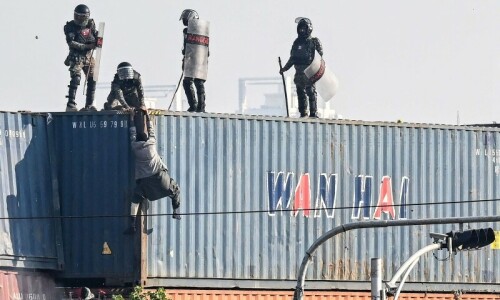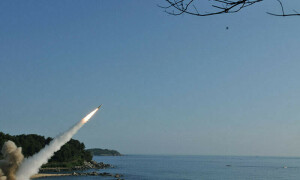THE state may have succeeded in pushing the protesters back from the streets of the capital on Tuesday night, but consider what it took to make that happen.
Even before the crowds had departed, the scale of the lockdown in Punjab was perhaps unprecedented, even compared to the pandemic. Speak with industry owners across the province and listen to the stories of shipments stuck — whether of raw material coming into factories or finished product ready for shipment to the port — and you will get a sense of how far-reaching the lockdown was.
The state won the showdown, there Is no doubt about that. But in order to win, they had to literally paralyse the largest province in the country, as well as its industrial heartland. Let’s not bother tallying up the losses the few days of shutdown inflicted on industry. Those are puny by comparison to the long-term losses we are all going to suffer on account of the manifest weakness of the state that the protest exposed.
This is the first time I have seen state authorities compelled to use so much violence to secure the streets of the capital. It is also the first time I have seen such extreme and stringent measures to ensure nobody from Punjab could come out to join the protest. Lockdowns were required to keep the pandemic at bay. They were also required to clear the air in the wake of the smog emergency.
But nowhere did the state move with such decisive speed to implement a near chokehold on the province, paralysing all intercity movement as well as digital traffic, as it did when a protest call needed to be thwarted. Given all that it took to contain the protest and then to beat it back, it can be asked whether or not the state’s is a Pyrrhic victory.
The mobs being mobilised are getting larger and larger with time. The amount of effort required to beat them back is also growing. The popular appeal of the PTI — a party that many allege runs on fake news churned out by robust disinformation machines — increases the repression they are subjected to. As it stands, this sounds like a losing battle.
In order to maintain its upper hand, the state has had to undertake a massive crackdown on the party’s followers and leaders, assemble a vast and unwieldy coalition of unlikely partners, concentrate power in the hands of the executive, dilute the independence of the judiciary, bring in draconian laws to regulate the internet, and hold people in custody without charge for prolonged periods. And after doing all this, they still had to fight it out in the streets of the capital, on the edge of the Red Zone itself, with bullets and tear gas.
For a ruler of a country in the modern era, power is the ability to provide livelihoods to his people, first and foremost.
If people in the state are feeling triumphant right now, they should note that the trajectory of their power is trending in the opposite direction.
This is why it is important to understand that, contrary to the saying made famous by that scene in the Game of Thrones, power is not power. In truth the protest march earlier this week was a demonstration of massive popular power, despite the fact that it ended in the way it did.
For a ruler of a country in the modern era, power is the ability to provide livelihoods to his people, first and foremost. It is only after this has been secured that all other elements begin to kick in. Power is certainly the ability to protect the territory of the state, but in order to do so the ruler needs revenues because that sort of protection is expensive, especially in modern times. And those revenues come from the system of livelihoods that the country operates.
The economic welfare of the people is intimately linked with the power of the ruler. A system of rule that leaves its own people increasingly impoverished, increasingly deprived of the basic elements of modern life — livelihood, opportunity, liberty — will necessarily struggle to sustain itself. And as part of this struggle, the people who rule the country where such a dysfunctional system operates will seek external patrons to help them meet the costs of their own rule at home.
The protests have been beaten back, and the leadership of the PTI cut a very sorry figure through the whole episode. Many leaders were conspicuous by their absence, and those who came either left early or fled at the very moment of truth that they said they were leading their own followers towards.
There is little doubt that there will be an internal reckoning within the party in the days to come as rival factions blame each other for the humiliating ending. The party’s vanguard has been bruised, its leadership humiliated.
But the party will bounce back from this setback like it has from every other setback so far. The reason is because the wellsprings of discontentment that provide it with its most vital fuel are still functioning, and so long as that is the case, all it takes is a story after every setback to refuel and prepare for the next encounter.
Even if the party is defeated — let’s say by a wide-ranging crackdown across KP, following the imposition of governor’s rule, (assuming it comes to that) — the challenge it poses to power today will reappear under a different name, a different banner. Force alone is not sufficient to fend off this challenge.
This presents the ruler with a conundrum. How do you defeat an adversary that only gains in strength from every blow that you inflict on it? There is no simple answer here, but there is a simple truth to keep in mind in such a situation. The powers of the state alone cannot fend off this challenge. Ultimately you can only fight lies with truth and despair with hope. And these are not dispensed as charity or as commands.
The writer is a business and economy journalist.
Published in Dawn, November 28th, 2024













































Dear visitor, the comments section is undergoing an overhaul and will return soon.